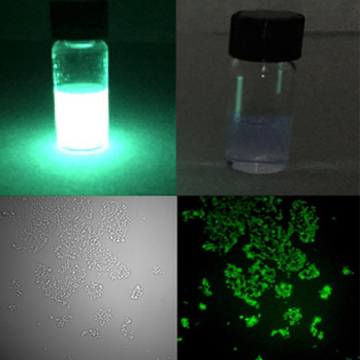
A new chemiluminescent probe (left), much brighter than the luminol (right) currently used in crime scenes, can be used directly in cells (below), unlike most chemiluminescent systems today. Image: American Chemical Society
Researchers from Tel Aviv University, Israel, and the University of Geneva, Switzerland, have developed a modular molecular methodology for creating single-molecule dioxetane probes with enhanced chemiluminescence. The probes—which are are biocompatible—could be used for cell imaging (ACS Cent. Sci., doi: 10.1021/acscentsci.7b00058). And, according to the team, the chemiluminescence quantum yield of their brightest probe design was 3,000 times higher than standard, commercially available dioxetane probes.
The researchers applied their methodology to create an enzyme-specific chemiluminescent probe and demonstrated its use for high-quality cell microscopy. According to the team, this was the first demonstration of cell imaging using a non-luciferin small-molecule chemiluminescence probe.
Creating a bright single-molecule probe
Chemiluminescent systems typically include an emitter molecule that attaches to a target and two additional molecules—a fluorophore and a surfactant—that attach to the emitter molecule and amplify its light signal to detectable levels. These systems, like luminol and oxalate esters, are widely used for applications such as DNA detection and immunoassays. However, energy is lost during the oxidation-based mechanism that boosts the signal from the emitter molecule to the amplifying molecules. And, because they contain surfactants, these systems are often not biocompatible.
The researchers, led by Doron Shabat, created a method for making more energy-efficient chemiluminescent probes by “tweaking” the emitter’s electronic structure to amplify its light signal without help from a fluorophore or a bio-incompatible surfactant. (The base of this methodology is Schaap’s adamantylidene-dioxetane, a single-molecule probe that doesn’t require an oxidation step for chemiluminescence.) Shabat and his colleagues incorporated several different substituents (i.e., tweaks) to boost the single-molecule’s chemiluminescence quantum yield.
After testing several substituents, the team found that adding acrylate and acrylonitrile electron-withdrawing groups to the emitter’s structure upped the chemiluminescence emission by three orders of magnitude when compared to a commercially available adamantylidene-dioxetane probe.
Single-molecule probes and cell imaging
The researchers used their super-bright single-molecule probe design methodology to develop customized biocompatible sensors for several analytes and enzymes for chemiluminescent cell microscopy. They demonstrated their method using a sensor for detecting intracellular activity of beta-galactosidase. According to the authors, the demonstration resulted in chemiluminescence cell images with “unprecedented quality.”
The authors believe their strategy will someday “lead to the development of efficient chemiluminescent probes for various applications in the field of sensing and imaging.”
